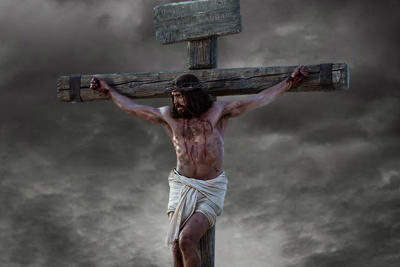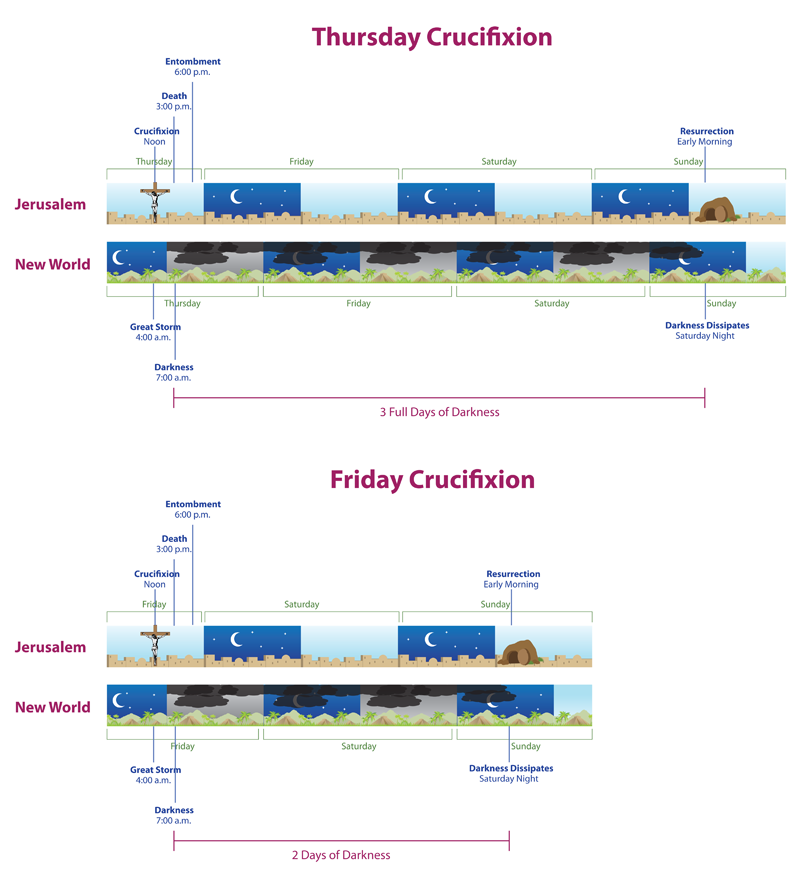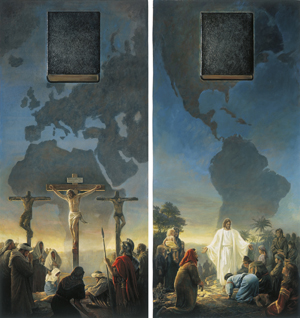You are here
How Does the Book of Mormon Help Date Christ’s Death?

Helaman 14:20
The Know
The Book of Mormon records the precise day the Nephites witnessed the prophesied sign of Christ’s death (3 Nephi 8:5).1 This exceptional diligence on the part of Nephite record-keepers may help resolve at least two questions that New Testament scholars debate regarding the timing of Christ’s death.
What Year Did Christ Die?
The first question relates to the year Christ was crucified. The New Testament accounts tie Christ’s crucifixion to a Passover festival during the governorship of Pontius Pilate (AD 26–36).2 Using astronomical data to calculate the timing of the Passover, scholars have determined that the years AD 27, 30, and 33 “are the only years during the administration of Pontius Pilate when the eve of Passover, and Passover itself, fell within a three-day window of time prior to Sunday,” the day of the Resurrection.3
Of these three years, based on additional factors involved in correlating the Gospel accounts to confirmable historical details, “Most scholars … believe that Jesus was killed in [AD] 30.”4 The issue is not definitively settled, however, and some scholars still “believe that he died in [AD] 33.”5
Thanks to the diligence of Nephite record-keepers, the Book of Mormon helps to narrow down the length of Christ’s life even further. Since Christ must have been born ca. 5–4 BC, this effectively rules out AD 27 as too short and AD 33 as too long to accommodate for Christ’s death happening in the first month of the 34th year in the Nephite calendar (3 Nephi 8:5).6 Thus, in the view of LDS archaeologist Jeffrey Chadwick, combining the Book of Mormon with the additional evidence from the New Testament, archaeology, astronomy, and history makes AD 30 the correct year, “beyond any reasonable doubt.”7
On What Day of the Week Did Christ Die?
The second question relates to the day of the week Christ was crucified. Long-standing tradition holds that Christ died on a Friday, and most New Testament scholars support this tradition.8 A few scholars, however, have suggested that Christ actually died on a Thursday.9 These scholars argue that a Thursday can better account for passages in the New Testament which speak of “three days and three nights” in the tomb (Matthew 12:40), and of the resurrection occurring after three days (Matthew 27:63; Mark 8:31), and Sunday being three days since the crucifixion (Luke 24:21).10
An important clue is John’s description of the upcoming Sabbath as “an high day” (John 19:31), meaning it was the first day of the Passover.11 Since certain festival days, such as Passover, were regarded as “Sabbaths,” no matter what day of the week they occurred (Leviticus 23: 7–8, 11, 15, 21, 24, 39),12 this allows for the possibility that the Sabbath after the crucifixion was not Saturday (the regular Jewish Sabbath), but the first day of Passover (a special “Sabbath,” or “high day”), which most likely fell on Friday in AD 30.13
While the New Testament data does not decisively favor Thursday, the Book of Mormon adds some important information. Nephite prophets predicted that there would be three days of darkness coinciding with the time of Christ’s death until his resurrection (1 Nephi 19:10; Helaman 14:20–27). Nephite historians documented the fulfillment of this prophecy (3 Nephi 8:19–23; 10:9).
Due to the time difference between Jerusalem and the New World, “a Friday crucifixion leads to only two days of darkness in the New World” before Christ rose on Sunday morning.14 A Thursday crucifixion, however, “exactly fits the timing necessary for three days of darkness to have occurred in America prior to Jesus’s resurrection” (see table).15
Chart by Book of Mormon Central. Jerusalem and New World Timelines reflect an eight hour time difference, and the Jewish tradition of beginning a new day at sunset.
The Why
As a second witness of Jesus Christ, readers should not be surprised that the Book of Mormon adds clarity to the timing of events in the Savior’s life. All who embrace the Book of Mormon should appreciate the ways this sacred volume can illuminate the timing of an event as important as the death and entombment of Jesus Christ. Jeffrey R. Chadwick reflected this point of view when he wrote:
As a Latter-day Saint, I am not only duty-bound but personally grateful to accept and present data from the Book of Mormon, the genuine historical reliability of which I am both spiritually and materially convinced, to corroborate the evidence of the New Testament and the other avenues explored.16
Openness and flexibility to new evidence and alternative interpretations should always be maintained, but the dating strongly supported by the Book of Mormon deserves serious consideration by all Latter-day Saints. If both the day and the year are correct, then the Savior died on Thursday, April 6, AD 30.17 This gives profound significance to the timing of the Restoration of His church, exactly 1800 years later.
Whatever the particulars in the timing of the Savior’s death, no detail is more important, or inspiring, than the fact that by Sunday morning, the tomb was found empty, with angels declaring “He is not here: for he is risen” (Matthew 28:6; Mark 16:6; Luke 24:6). As President Monson taught, “No words in Christendom mean more to me than those spoken by the angel to the weeping Mary Magdalene and the other Mary when, on the first day of the week, they approached the tomb to care for the body of their Lord. … Our Savior lived again.”18
President Gordon B. Hinckley taught, “The abject sorrow that comes with death, the bereavement that follows the passing of a loved one are mitigated only by the certainty of the Resurrection of the Son of God that first Easter morning. … In the hour of deepest sorrow we draw hope and peace and certitude from the words of the angel that Easter morning.”19
He would show Himself to His disciples in Jerusalem, and then later that year, He appeared in glory to the Nephites as well (3 Nephi 11). Together, the Bible and the Book of Mormon forcefully testify that Jesus Christ lives! Modern prophets continue to testify “that Jesus is the Living Christ, the immortal Son of God.”20 No truth could be more beautiful, nor of greater eternal significance than this. Latter-day Saints should appreciate and cherish these added scriptural and prophetic witnesses of the Risen Lord.
Further Reading
Jeffrey R. Chadwick, “Dating the Death of Jesus Christ,” BYU Studies 54, no. 4 (2015): 135–191.
Lincoln H. Blumell and Thomas A. Wayment, “When was Jesus Born? A Response to a Recent Proposal,” BYU Studies 51, no. 3 (2012): 64–70.
David B. Cummings, “Three Days and Three Nights: Reassessing Jesus’s Entombment,” Journal of Book of Mormon Studies 16, no. 1 (2007): 56–73, 86.
- 1. Cf. 1 Nephi 12:1–3, 5; 19:10–11; Helaman 14:20–27. For details on the prophecy and its fulfillment, see Book of Mormon Central, “Why Did Samuel Make Such Chronologically Precise Prophecies? (Helaman 13:5),” KnoWhy 184 (September 9, 2016); Book of Mormon Central, “What Caused the Darkness and Destruction in the 34th Year? (3 Nephi 8:20),” KnoWhy 197 (September 28, 2016).
- 2. See Matthew 26–27; Mark 14–15; Luke 22–23; John 12–19; Jeffrey R. Chadwick, “Dating the Death of Jesus Christ,” BYU Studies 54, no. 4 (2015): 136–139. According to most scholars, the Synoptic Gospels (Matthew, Mark, Luke) differ with John on whether it was the day before Passover (14th of Nisan) or the day of Passover (15th of Nisan). See Lincoln H. Blumell and Thomas A. Wayment, “When was Jesus Born? A Response to a Recent Proposal,” BYU Studies 51, no. 3 (2012): 65; Richard Neitzel Holzaphel, Eric D. Huntsman, and Thomas A. Wayment, Jesus Christ and the World of the New Testament (Salt Lake City, UT: Deseret Book, 2006), 137–138; Thomas A. Wayment, “The Birth and Death Dates of Jesus Christ,” in The Life and Teachings of Jesus Christ, 3 vols., ed. Richard Neitzel Holzapfel and Thomas A. Wayment (Salt Lake City, UT: Deseret Book, 2005), 1:391–392; Stanley E. Porter, “Chronology of the New Testament,” in Eerdmans Dictionary of the Bible, ed. David Noel Freedman (Grand Rapids, MI: Wm. B. Eerdmans, 2000), 249–250. For a reconciliation favoring the 14th of Nisan, see Chadwick, “Dating the Death of Jesus Christ,” 165–172. For a reconciliation favoring the 15th of Nisan, see Craig L. Blomberg, The Historical Reliability of Gospels, 2nd edition (Downers Grove, IL: InterVarsity Press, 2007), 221–225. On the timing of Pilate’s governorship, see Emily Cheney, “Pilate, Pontius,” in Eerdmans Dictionary, 1058.
- 3. Chadwick, “Dating the Death of Jesus Christ,” 156, see also the chart on p. 157. Porter, “Chronology of the New Testament,” 250 adds AD 36, but also determines that “27 is too early and 36 too late” to work with other factors. Blumell and Wayment, “When was Jesus Born?” 64–70 expands the range of possible dates based on the possibility of misidentifying the new moon. Chadwick, “Dating the Death of Jesus Christ,” 158–165 responds to this argument. Randall P. Spackman, “Introduction to Book of Mormon Chronology: The Principal Prophecies, Calendars, and Dates,” (FARMS Preliminary Reports, 1993), 60–68, plus appendix 2, argued that the Book of Mormon supports a death date in AD 29, but this date has little support from New Testament scholars.
- 4. Porter, “Chronology of the New Testament,” 250. See Chadwick, “Dating the Death of Jesus Christ,” 139–142 for documentation that this is the view of most scholars. See also Wayment, “The Birth and Death Dates of Jesus Christ,” 393–394; Holzapfel, Huntsman, and Wayment, Jesus Christ and the World of the New Testament, 44; John H. Walton and Craig S. Keener, eds., NIV Cultural Backgrounds Study Bible (Grand Rapids, MI: Zondervan, 2016), 1593, 1667, 1863–1864; Ben Witherington III, “Images of Crucifixion: Fresh Evidence,” Biblical Archaeological Review 39, no. 2 (2013): 28; Blomberg, Historical Reliability of Gospels, 225: “the only year close to the time of Christ’s ministry in which he could have been crucified would have been AD 30. … AD 30 turns out to be the very year many scholars have accepted as the year of Christ’s death.”
- 5. Porter, “Chronology of the New Testament,” 250. See, for example, Paul Barnett, Jesus and the Rise of Early Christianity: A History of New Testament Times (Downers Grover, IL: InterVarsity Press, 1999), 155.
- 6. See Book of Mormon Central, “How Does the Book of Mormon Help Date the First Christmas? (3 Nephi 1:13),” KnoWhy 255 (December 21, 2016). See also Jeffrey R. Chadwick, “Dating the Birth of Jesus Christ,” BYU Studies 49, no. 4 (2010): 17–18; Chadwick, “Dating the Death of Jesus Christ,” 142–149.
- 7. Chadwick, “Dating the Death of Jesus Christ,” 190.
- 8. Representing this traditional view and forcefully rejecting the Thursday argument are Blumell and Wayment, “When was Jesus Born?” 65–66, 78–79 nn.51–57. For a response, see Chadwick, “Dating the Death of Jesus Christ,” 176–177, 179–180 n.108.
- 9. See Chadwick, “Dating the Death of Jesus Christ,” 172. David B. Cummings, “Three Days and Three Nights: Reassessing Jesus’s Entombment,” Journal of Book of Mormon Studies 16, no. 1 (2007): 58 also mentions “advocates of Wednesday” as the day of Christ’s death.
- 10. See Chadwick, “Dating the Death of Jesus Christ,” 174–177; Cummings, “Three Days and Three Nights,” 59.
- 11. See Chadwick, “Dating the Death of Jesus Christ,” 177–182.
- 12. Chadwick, “Dating the Death of Jesus Christ,” 138; Cummings, “Three Days and Three Nights,” 60.
- 13. There is uncertainty on whether the new moon would have been observed on the correct day in AD 30, making it possible that the 14th of Nisan (the day before Passover, and most likely day of crucifixion) was on Thursday (the correct day), or Friday (if the new moon was observed a day late). This would make the 15th of Nisan (the first day of Passover) either Friday (the correct day), or Saturday (if the new moon was observed a day late). See Chadwick, “Dating the Death of Jesus Christ,” 154–158. Since most scholars favor an AD 30 date and a Friday for the day of crucifixion, they assume the new moon was not observed on the correct day, and that the 14th of Nisan was thus a day late, on Friday. Chadwick’s position—that AD 30 is the year, and thus Christ’s death happened on a Thursday (the correct day for the 14th of Nisan)—seems more consistent. In fact, Blomberg, Historicity of the Gospels, 221–225 favors AD 30 precisely because it is the only year the 15th of Nisan fell on Friday and, unlike most New Testament scholars, he favors the Synoptics’ chronology (Christ dying on the first day of Passover) over that of John’s.
- 14. Cummings, “Three Days and Three Nights,” 63, cf. pp. 60–63; Chadwick, “Dating the Death of Jesus Christ,” 182–188.
- 15. Chadwick, “Dating the Death of Jesus Christ,” 184, cf. the charts on pp. 186–187. See also figs. 1 and 2 in Cummings, “Three Days and Three Nights,” 62–63.
- 16. Chadwick, “Dating the Death of Jesus Christ,” 190, capitalization altered.
- 17. Chadwick, “Dating the Death of Jesus Christ,” 136.
- 18. Thomas S. Monson, “He Is Risen,” Ensign, May 2010, 89, online at lds.org.
- 19. Gordon B. Hinckley, “This Glorious Eastern Morn,” Ensign, May 1996, online at lds.org.
- 20. “The Living Christ: The Testimony of the Apostles,” Ensign, April 2000, online at lds.org, emphasis added.
KnoWhy Citation
Related KnoWhys
Subscribe
Get the latest updates on Book of Mormon topics and research for free








